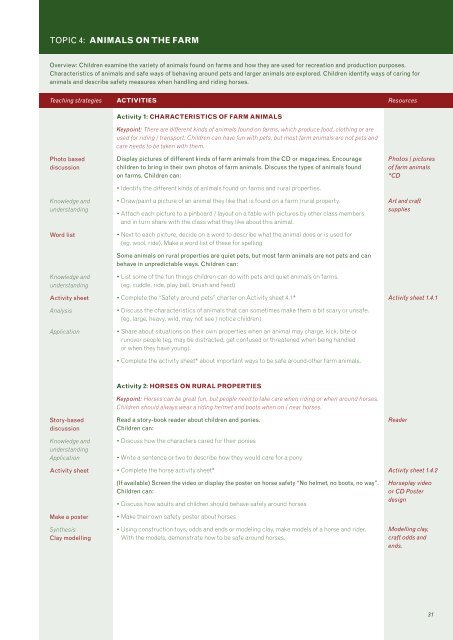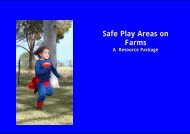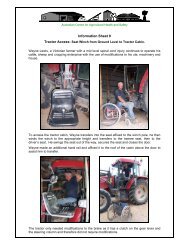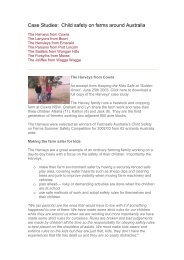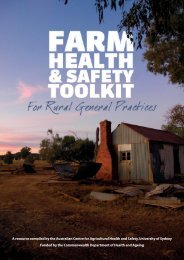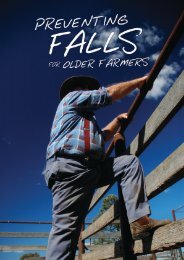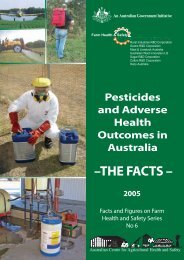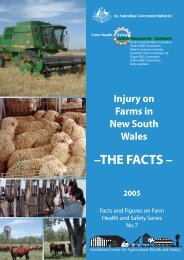Ripper ii Educational resource for primary schools - Australian ...
Ripper ii Educational resource for primary schools - Australian ...
Ripper ii Educational resource for primary schools - Australian ...
You also want an ePaper? Increase the reach of your titles
YUMPU automatically turns print PDFs into web optimized ePapers that Google loves.
TOPIC 4: ANIMALS ON THE FARMOverview: Children examine the variety of animals found on farms and how they are used <strong>for</strong> recreation and production purposes.Characteristics of animals and safe ways of behaving around pets and larger animals are explored. Children identify ways of caring <strong>for</strong>animals and describe safety measures when handling and riding horses.Teaching strategies ACTIVITIES ResourcesActivity 1: CHARACTERISTICS OF FARM ANIMALSKeypoint: There are different kinds of animals found on farms, which produce food, clothing or areused <strong>for</strong> riding / transport. Children can have fun with pets, but most farm animals are not pets andcare needs to be taken with them.Photo baseddiscussionKnowledge andunderstandingWord listKnowledge andunderstandingActivity sheetAnalysisApplicationDisplay pictures of different kinds of farm animals from the CD or magazines. Encouragechildren to bring in their own photos of farm animals. Discuss the types of animals foundon farms. Children can:• Identify the different kinds of animals found on farms and rural properties.• Draw/paint a picture of an animal they like that is found on a farm /rural property.• Attach each picture to a pinboard / layout on a table with pictures by other class membersand in turn share with the class what they like about this animal.• Next to each picture, decide on a word to describe what the animal does or is used <strong>for</strong>(eg. wool, ride). Make a word list of these <strong>for</strong> spellingSome animals on rural properties are quiet pets, but most farm animals are not pets and canbehave in unpredictable ways. Children can:• List some of the fun things children can do with pets and quiet animals on farms.(eg. cuddle, ride, play ball, brush and feed)• Complete the “Safety around pets” charter on Activity sheet 4.1*• Discuss the characteristics of animals that can sometimes make them a bit scary or unsafe.(eg. large, heavy, wild, may not see / notice children)• Share about situations on their own properties when an animal may charge, kick, bite orrunover people (eg. may be distracted, get confused or threatened when being handledor when they have young).• Complete the activity sheet* about important ways to be safe around other farm animals.Photos / picturesof farm animals*CDArt and craftsuppliesActivity sheet 1.4.1Story-baseddiscussionKnowledge andunderstandingApplicationActivity sheetMake a posterSynthesisClay modellingActivity 2: HORSES ON RURAL PROPERTIESKeypoint: Horses can be great fun, but people need to take care when riding or when around horses.Children should always wear a riding helmet and boots when on / near horses.Read a story-book reader about children and ponies.Children can:• Discuss how the characters cared <strong>for</strong> their ponies• Write a sentence or two to describe how they would care <strong>for</strong> a pony• Complete the horse activity sheet*(If available) Screen the video or display the poster on horse safety “No helmet, no boots, no way”.Children can:• Discuss how adults and children should behave safely around horses• Make their own safety poster about horses• Using construction toys, odds and ends or modeling clay, make models of a horse and rider.With the models, demonstrate how to be safe around horses.ReaderActivity sheet 1.4.2Horseplay videoor CD PosterdesignModelling clay,craft odds andends.31


